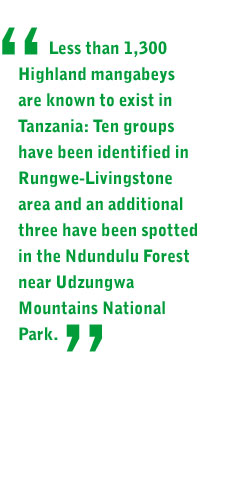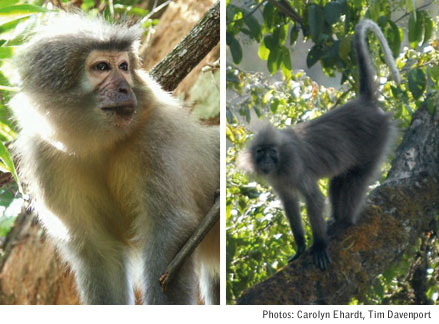


New Primate Found in Africa
by Judy Purdy
Intro
| No Luck Then a Jackpot
| Co-Discovery
| Demonstrating the Value of the Forests
| Nature of the Species

![]()

No Luck Then a Jackpot
Desperate to observe these new monkeys, Ehardt decided in August she could wait no longer. Despite doctor’s orders to remain stateside for six weeks after radiation treatment, she booked a flight to Kenya and invited Butynski to join the expedition. Together they journeyed south from Nairobi to join Jones and her other field assistants on a trek into the Ndundulu Forest. Arriving at the place where the Danes and her field assistants had seen monkeys, they split into three groups, scoured the forests and six days later were finally gazing at the unusual-looking mangabeys.
“Tom and I stood there intently looking at them through our binoculars,” she said. “Fortunately, they were feeding in trees on the other side of a valley and hadn’t seen us, so we were able to get good looks at them before they fled. We just watched and watched and watched.”
“At just about the same time we put our binoculars down, looked at each other and went, ‘Uh-huh … amazing!’ We knew it was a new species. You can’t imagine how exciting it was to be looking at something that had never been known to science before.”
In the following weeks, Ehardt and Butynski deciphered the taxonomic placement of the new species. The trio wrote up their findings, submitted their paper to Science and held their tongues in observance of the journal’s prepublication embargo.

The Sanje mangabey, first reported in 1981, is among the world’s top 25 most endangered primates. These shy monkeys, which live only in two remote mountain forests of Tanzania, have eyelids that are lighter than the rest of the face — a characteristic that may have evolved as a signaling mechanism. By contrast, the recently discovered Highland mangabey has eyelid color that matches the face, plus a crest of hair that sticks straight up from its head.
With the manuscript under review, Ehardt drove to Dar-es-Salaam in October to re-register her dying research vehicle, check her email and stock up on supplies. She also was to meet with a Wildlife Conservation Society representative, who also would be in Dar-es-Salaam at the time. Although she had never met Graeme Patterson, WCS’s Africa Program assistant director, the two had corresponded when she was preparing her grant proposal to study Sanje mangabeys.
“While driving over,” she said, “I’m thinking, should I say anything to Graeme about this new discovery? I decided to swear him to secrecy and tell him; after all, the greatest portion of my funding that led to this discovery was from WCS, and I knew they would be excited about what had been produced through their generous support.”
While she and Patterson were shaking hands, he mentioned that Tim Davenport, director of WCS’s Southern Rift and Southern Highlands Conservation Program, was in town and also wanted to meet her. Ehardt quickly decided to swear both men to secrecy and soon she was describing the new monkey in vivid detail. As she talked, she said she saw them “looking intensely at her and then at each other, expressions of incredulity spreading across their faces, and Davenport was growing increasingly agitated.”
It turned out that Davenport’s team was preparing a manuscript that described the same species. “Now both of us were staring at each other in unbridled disbelief,” Ehardt said.
Davenport hurriedly retrieved his computer, set it on the table and scrolled through several photos. The two teams independently had co-discovered the same new species in two disparate locations unbeknownst to each other. “They actually found the animal in their site before we did,” Erhardt said.
Intro
| No Luck Then a Jackpot
| Co-Discovery
| Demonstrating the Value of the Forests
| Nature of the Species
For comments or for information please e-mail: rcomm@uga.edu
To contact the webmaster please email: ovprweb@uga.edu
![]()